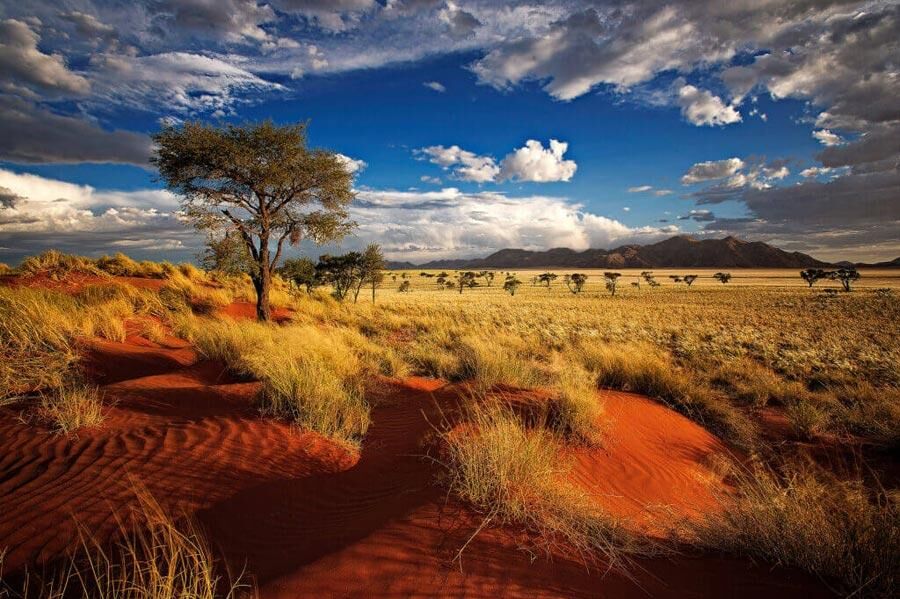
Experience an African plains game hunting safari with a difference: Try your hand at hunting the world’s tallest animal! The giraffe (Giraffa camelopardalis) is an iconic species for any African hunting adventure and is a sought-after hunting trophy amongst hunting enthusiasts. There are four species of giraffe in Africa, namely the northern giraffe, southern giraffe, Masai giraffe, and reticulated giraffe, with the southern giraffe being the most common type and found in Namibia. The southern giraffe comprises two sub-species, namely the Angolan giraffe and the South African giraffe. In Namibia, the primary subspecies of giraffe hunted is the Angolan giraffe (Giraffa camelopardalis angolensis). This giraffe subspecies has adapted well to inhabit the country’s arid and semi-arid regions, ensuring a healthy and stable population. Reaching up to 20 feet tall and a whopping 4,200 pounds, the giraffe is a welcome sight across Namibian landscapes, with the northern region of the country, especially the Kunene region, being prime giraffe hunting grounds. Other popular hunting areas to visit are in the northeastern and eastern parts of Namibia. Apart from their enormously long necks, giraffes are renowned for their unusual patchy coats. With a light or tan background, and dissimilar, uneven patches scattered throughout the coat, the giraffe is a walking masterpiece of camouflage and color. Along with its long neck and short body, a giraffe also has very long, muscular legs that are over 6 feet long. Although a giraffe is generally a docile creature, should they feel threatened or be attacked, they will defend themselves, and one well-aimed kick can take down a variety of predators, even lions, permanently. Alternatively, reaching up to 35 miles per hour, the giraffe can outrun a variety of dangers, or perceived dangers on the savanna. Namibia offers hunters top-quality hunting safaris, with a giraffe hunt being a challenging endeavor to attempt. Giraffes prefer a habitat of dry savanna woodland and even some semi-desert regions. Wherever they choose to make their habitat, a basic requirement is sufficient water. Although they do not drink daily due to the plants they ingest providing moisture, adequate water is required.
Giraffe hunting may prove to be a testing hunt for game hunting enthusiasts. The animal’s height, combined with its keen eyesight and hearing provide a challenging stalking scenario for hunters. The International Union for the Conservation of Nature (IUCN) lists the giraffe’s Red List status as vulnerable, with a significant decline in the number of giraffes in the wild.
Shot Placement while Giraffe Hunting in Namibia
Shot placement on the giraffe is a relatively simple affair, with the hunter needing to avoid the high-risk shots such as the neck and head and must concentrate on a heart or lung shot, with the shot directed at the bottom third of the giraffe, directly above the shoulder. Remember to research the giraffe’s anatomy as that will assist you in being able to picture the vital organs and pinpoint the correct shot placement.
What Caliber Rifle is Used When Hunting Giraffe in Namibia?
Giraffes are extremely large and have very thick skin. Often when shot with a smaller caliber rifle, these animals do not “throw” a blood trail making it extremely difficult to track. A large caliber rifle such as a .376 H & H Magnum or .426 Rigby is recommended. Bow hunting of giraffes in Namibia is legal. For large game like giraffes, the bow must have an energy output of at least 88.13 joules (65 ft/lbs), and the arrow must weigh at least 29.16 grams (450 grain). Speak to your Namibian outfitter for further information and assistance.
Search from our range of Hunts across various popular destinations in Africa.
Find A Hunt